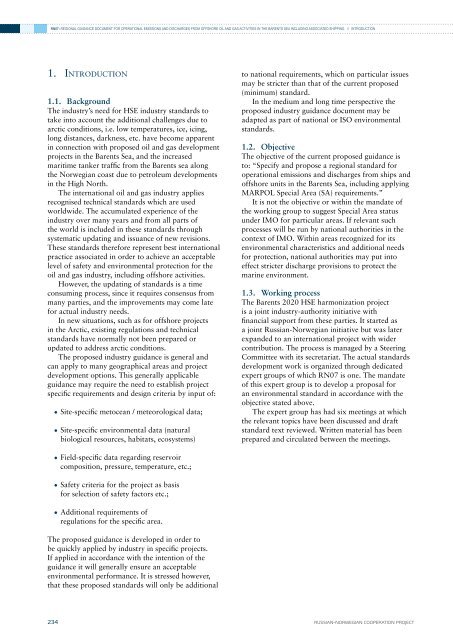phase 4 report - DNV
phase 4 report - DNV
phase 4 report - DNV
You also want an ePaper? Increase the reach of your titles
YUMPU automatically turns print PDFs into web optimized ePapers that Google loves.
RN07: REGIONAL GUIDANCE DOCUMENT FOR OPERATIONAL EMISSIONS AND DISCHARGES FROM OFFSHORE OIL AND GAS ACTIVITIES IN THE BARENTS SEA INCLUDING ASSOCIATED SHIPPING // Introduction1. Introduction1.1. BackgroundThe industry’s need for HSE industry standards totake into account the additional challenges due toarctic conditions, i.e. low temperatures, ice, icing,long distances, darkness, etc. have become apparentin connection with proposed oil and gas developmentprojects in the Barents Sea, and the increasedmaritime tanker traffic from the Barents sea alongthe Norwegian coast due to petroleum developmentsin the High North.The international oil and gas industry appliesrecognised technical standards which are usedworldwide. The accumulated experience of theindustry over many years and from all parts ofthe world is included in these standards throughsystematic updating and issuance of new revisions.These standards therefore represent best internationalpractice associated in order to achieve an acceptablelevel of safety and environmental protection for theoil and gas industry, including offshore activities.However, the updating of standards is a timeconsuming process, since it requires consensus frommany parties, and the improvements may come latefor actual industry needs.In new situations, such as for offshore projectsin the Arctic, existing regulations and technicalstandards have normally not been prepared orupdated to address arctic conditions.The proposed industry guidance is general andcan apply to many geographical areas and projectdevelopment options. This generally applicableguidance may require the need to establish projectspecific requirements and design criteria by input of:• Site-specific metocean / meteorological data;• Site-specific environmental data (naturalbiological resources, habitats, ecosystems)to national requirements, which on particular issuesmay be stricter than that of the current proposed(minimum) standard.In the medium and long time perspective theproposed industry guidance document may beadapted as part of national or ISO environmentalstandards.1.2. ObjectiveThe objective of the current proposed guidance isto: “Specify and propose a regional standard foroperational emissions and discharges from ships andoffshore units in the Barents Sea, including applyingMARPOL Special Area (SA) requirements.”It is not the objective or within the mandate ofthe working group to suggest Special Area statusunder IMO for particular areas. If relevant suchprocesses will be run by national authorities in thecontext of IMO. Within areas recognized for itsenvironmental characteristics and additional needsfor protection, national authorities may put intoeffect stricter discharge provisions to protect themarine environment.1.3. Working processThe Barents 2020 HSE harmonization projectis a joint industry-authority initiative withfinancial support from these parties. It started asa joint Russian-Norwegian initiative but was laterexpanded to an international project with widercontribution. The process is managed by a SteeringCommittee with its secretariat. The actual standardsdevelopment work is organized through dedicatedexpert groups of which RN07 is one. The mandateof this expert group is to develop a proposal foran environmental standard in accordance with theobjective stated above.The expert group has had six meetings at whichthe relevant topics have been discussed and draftstandard text reviewed. Written material has beenprepared and circulated between the meetings.• Field-specific data regarding reservoircomposition, pressure, temperature, etc.;• Safety criteria for the project as basisfor selection of safety factors etc.;• Additional requirements ofregulations for the specific area.The proposed guidance is developed in order tobe quickly applied by industry in specific projects.If applied in accordance with the intention of theguidance it will generally ensure an acceptableenvironmental performance. It is stressed however,that these proposed standards will only be additional234RUSSIAN–NORWEGIAN COOPERATION PROJECT






![Risk Based Pipeline Integrity Management [Compatibility Mode] - DNV](https://img.yumpu.com/50424229/1/190x146/risk-based-pipeline-integrity-management-compatibility-mode-dnv.jpg?quality=85)









